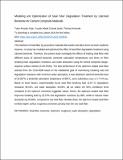Modeling and Optimization of Sisal Fiber Degradation Treatment by Calcined Bentonite for Cement Composite Materials

View/
Date
2024-10-06Author
Fode, Tsion
Chande Jande, Yusufu
Kivevele, Thomas
Metadata
Show full item recordAbstract
The treatment of sisal fiber by pozzolanic materials like kaolin and silica-fume has been explored; however, no study has modeled and optimized the effect of sisal fiber degradation treatment using calcined bentonite. Therefore, the present study investigate the effects of treating sisal fiber with different doses of calcined bentonite, bentonite calcination temperatures, and times on fiber breaking load, degradation resistance, and water absorption using the central composite design-response surface method (CCD-RSM). The best performance of the optimum treated sisal fiber selected from the CCD-RSM based on the established goal of maximizing breaking load and degradation resistance with minimum water absorption, it was obtained a calcined bentonite dose of 30.067%, a bentonite calcination temperature of 800°C, and a calcination time of 179.99 min. Based on these factors, experimentally found sisal fiber breaking load 12.87 N, degradation resistance 98.44%, and water absorption 39.05%, all are within the 95% confidence level compared to the optimum numerical suggested values. Hence, the optimum treated sisal fiber improved breaking load by 33.37% and degradation resistance by 98%, while it reduced water absorption by 60.95%, compared to raw sisal fiber. Besides these, the optimum treated sisal fiber exhibits higher surface roughness and lower porosity than the raw sisal fiber.
URI
https://doi.org/10.1080/15440478.2024.2408632https://dspace.nm-aist.ac.tz/handle/20.500.12479/2827
